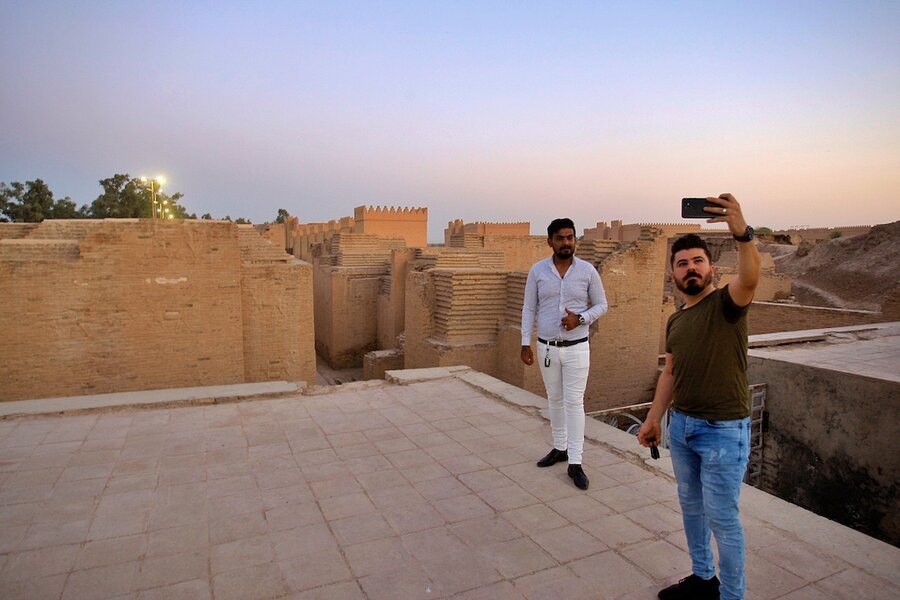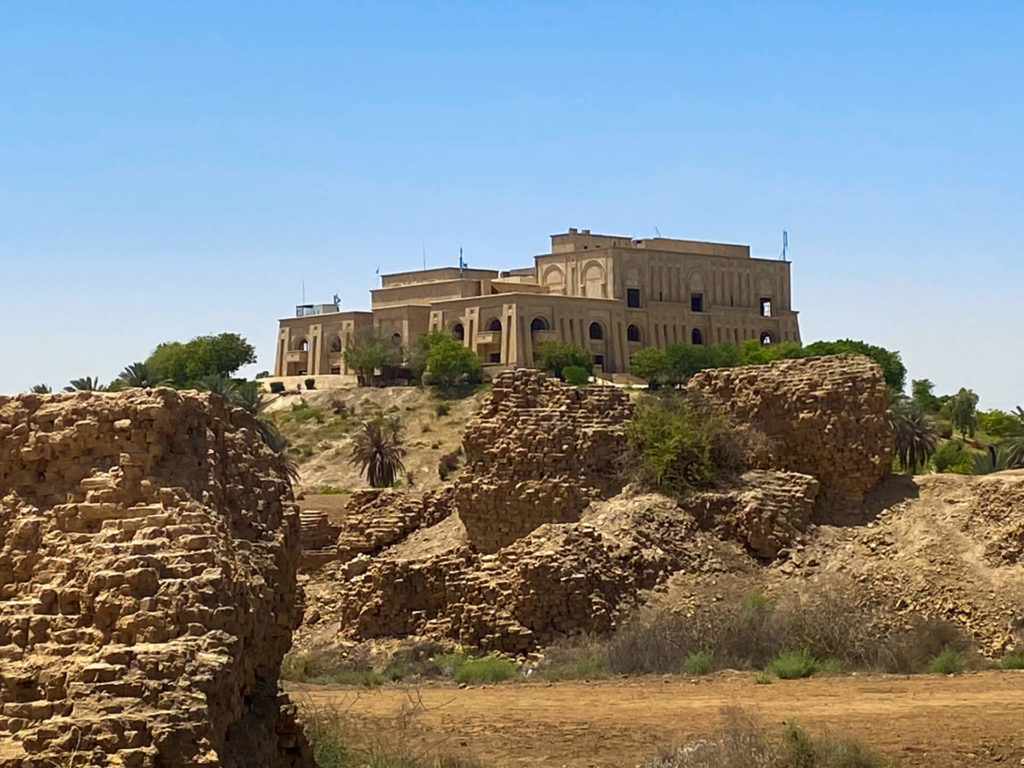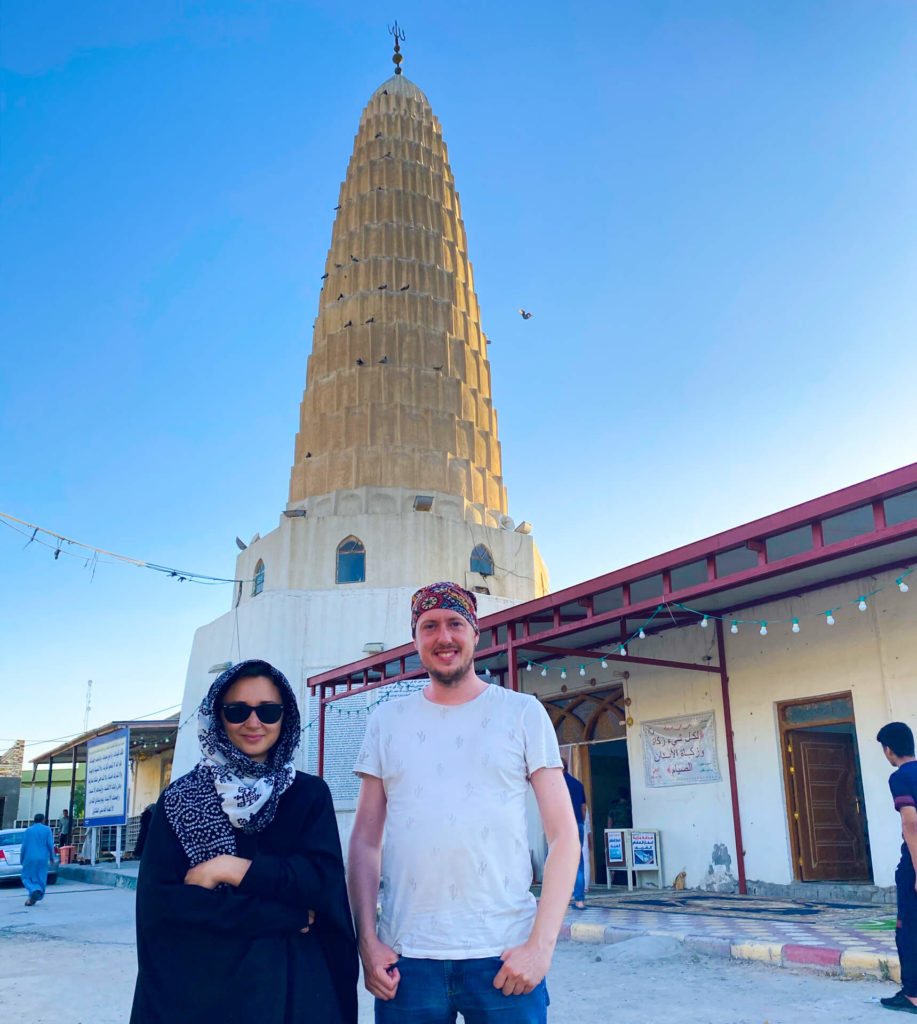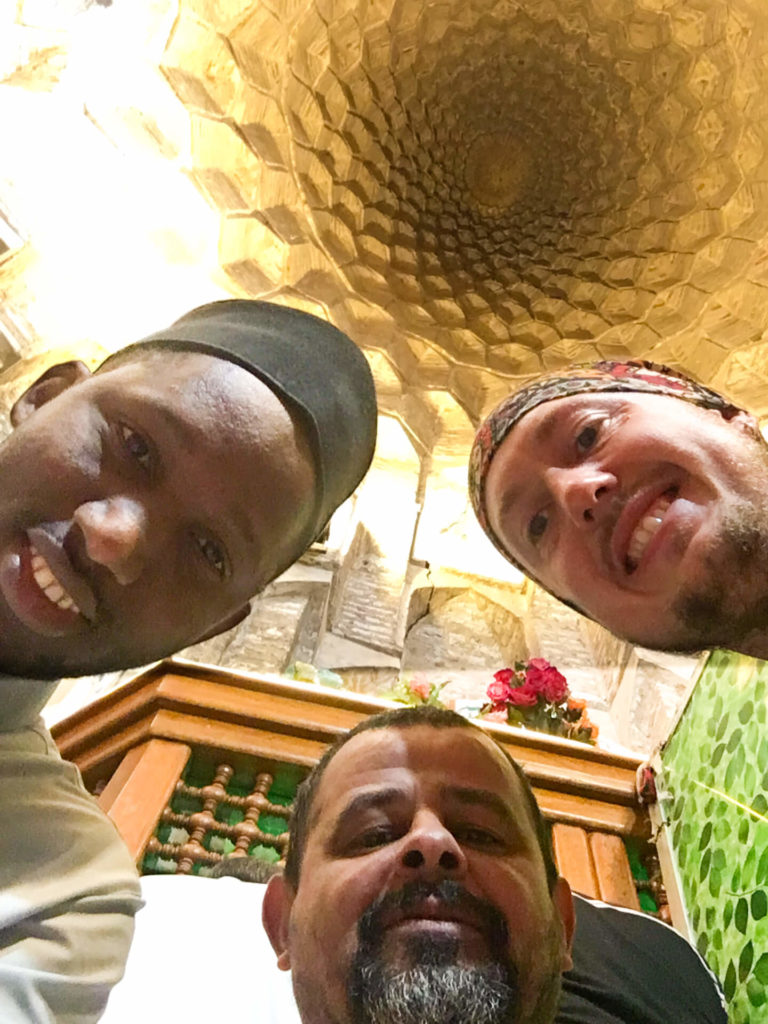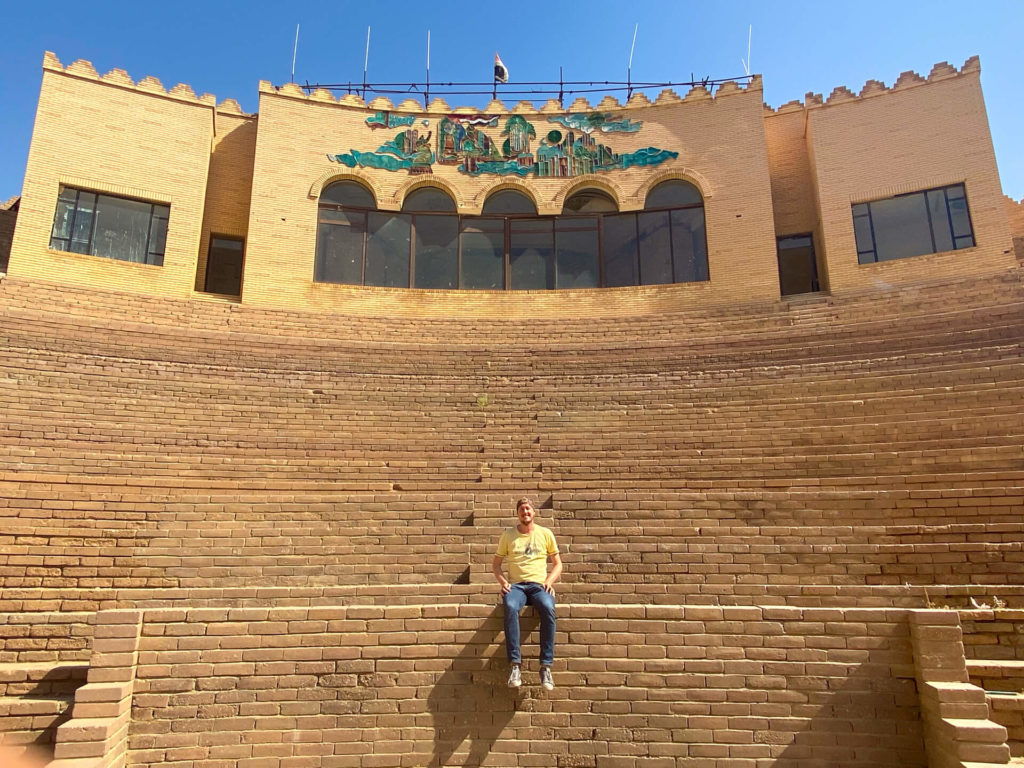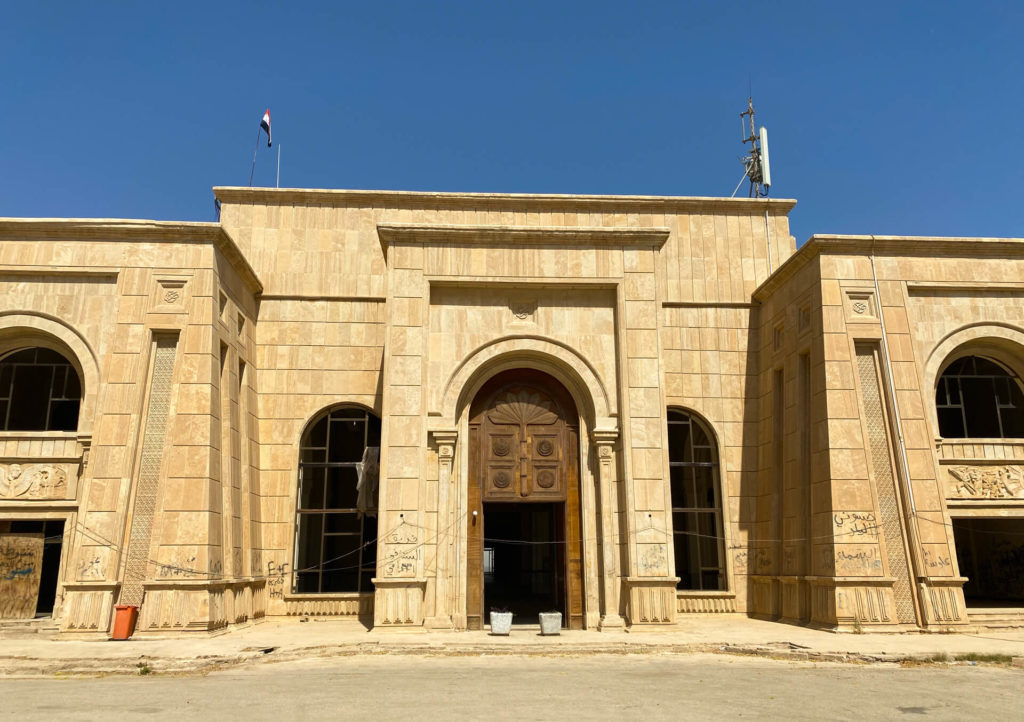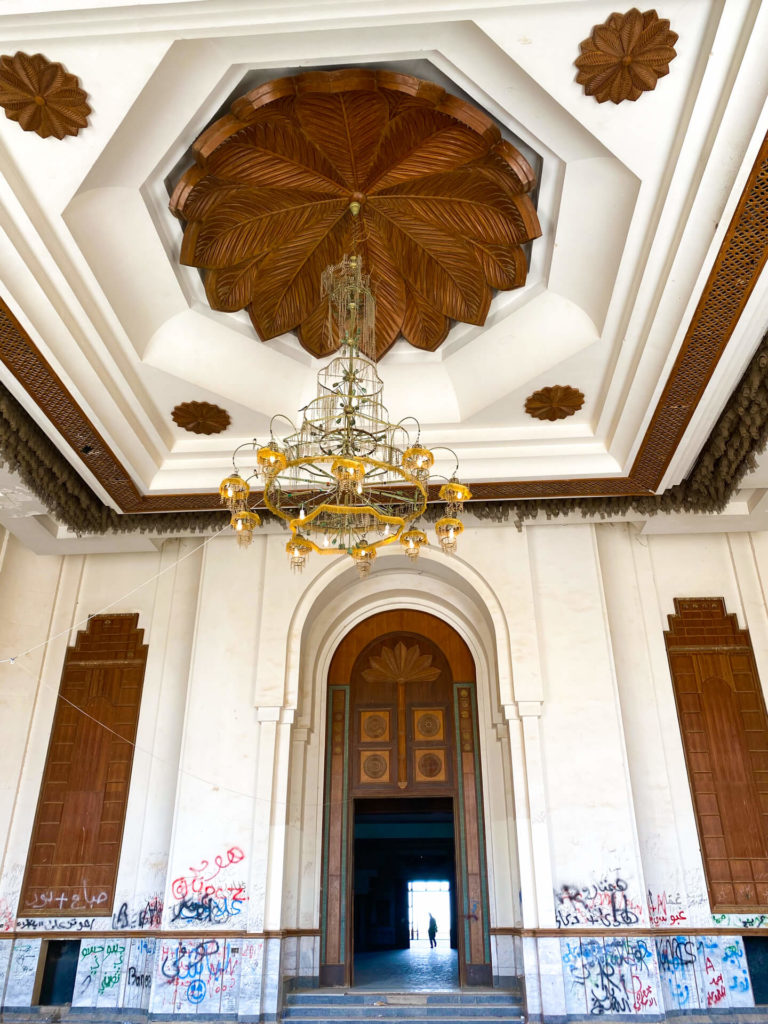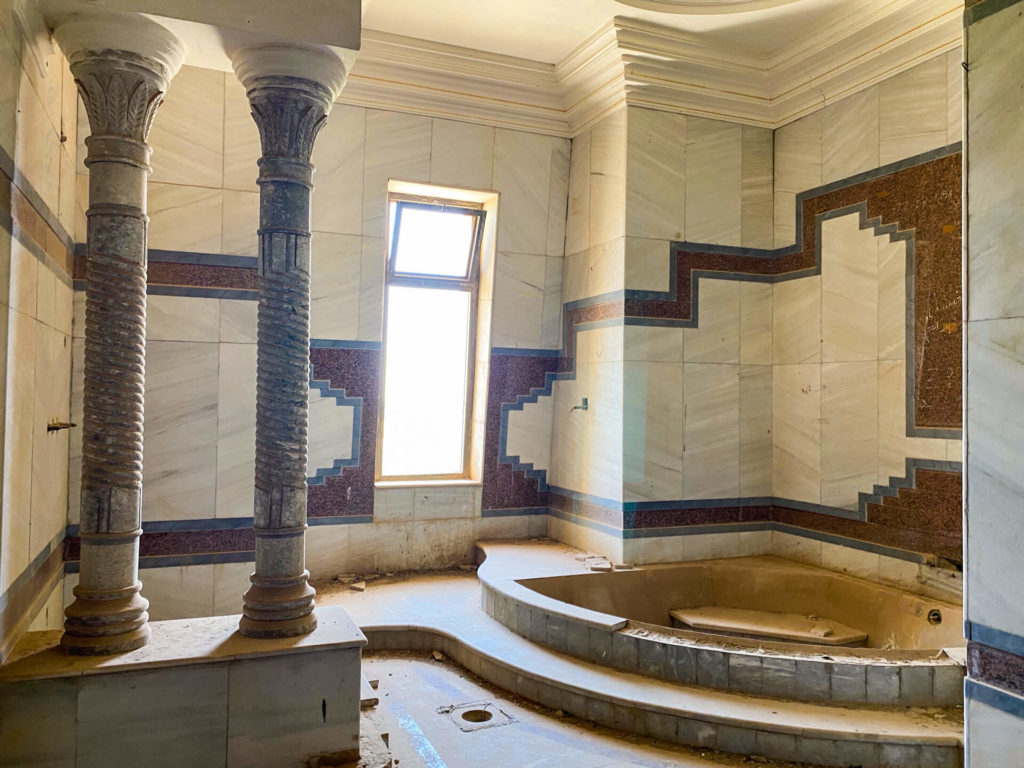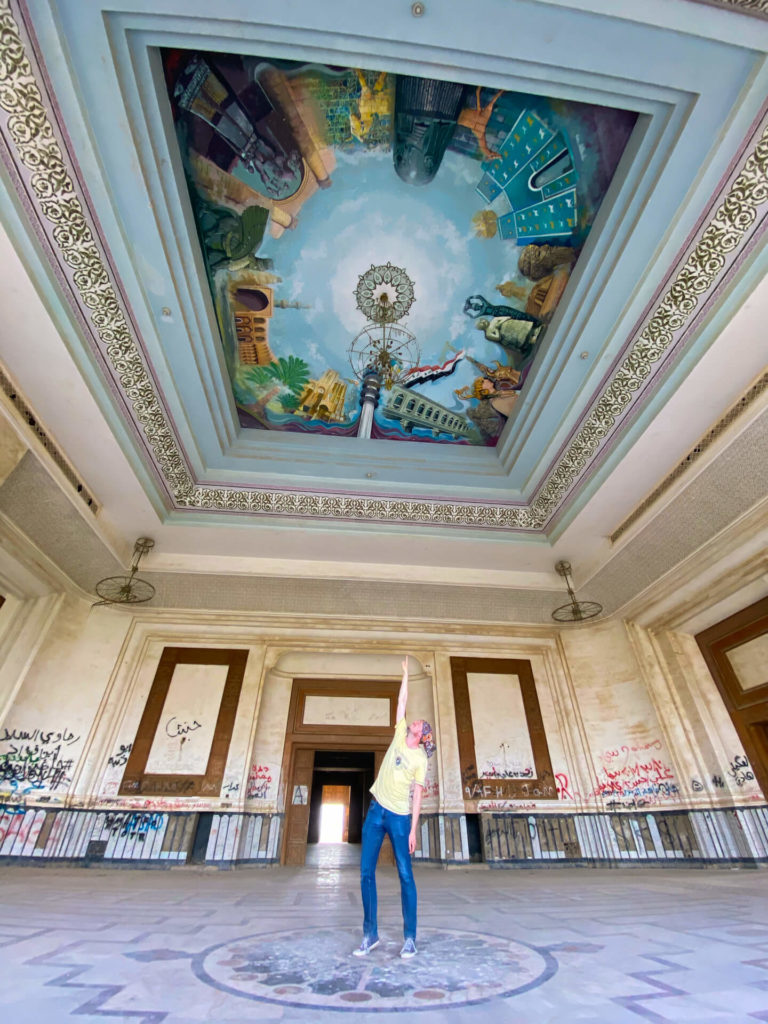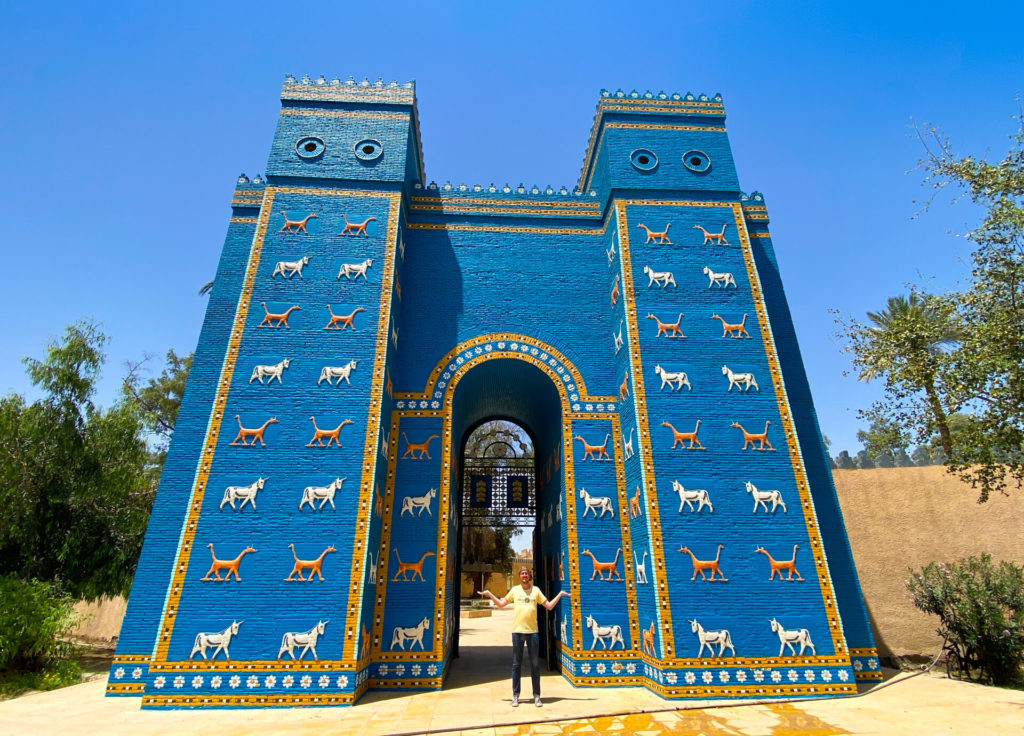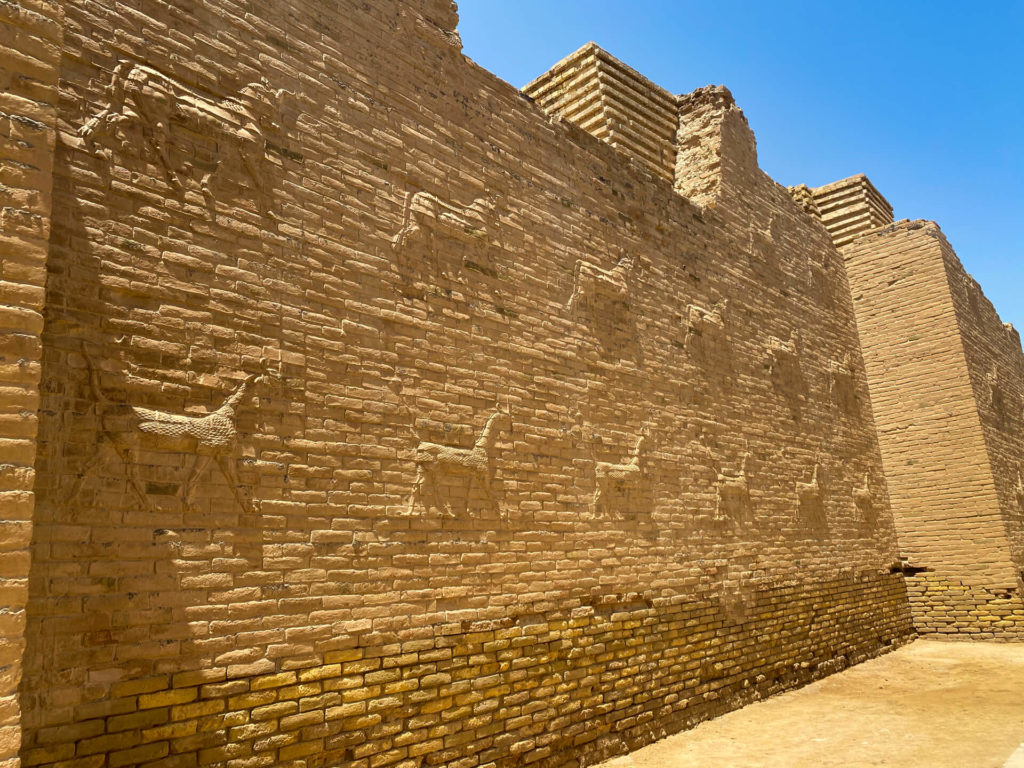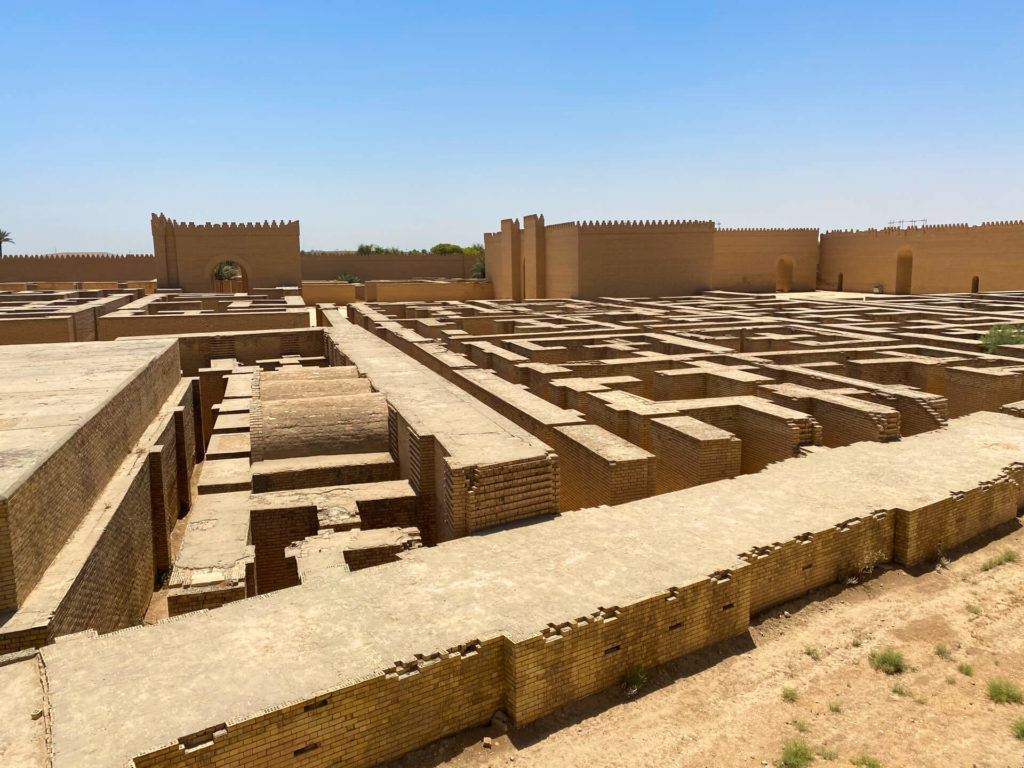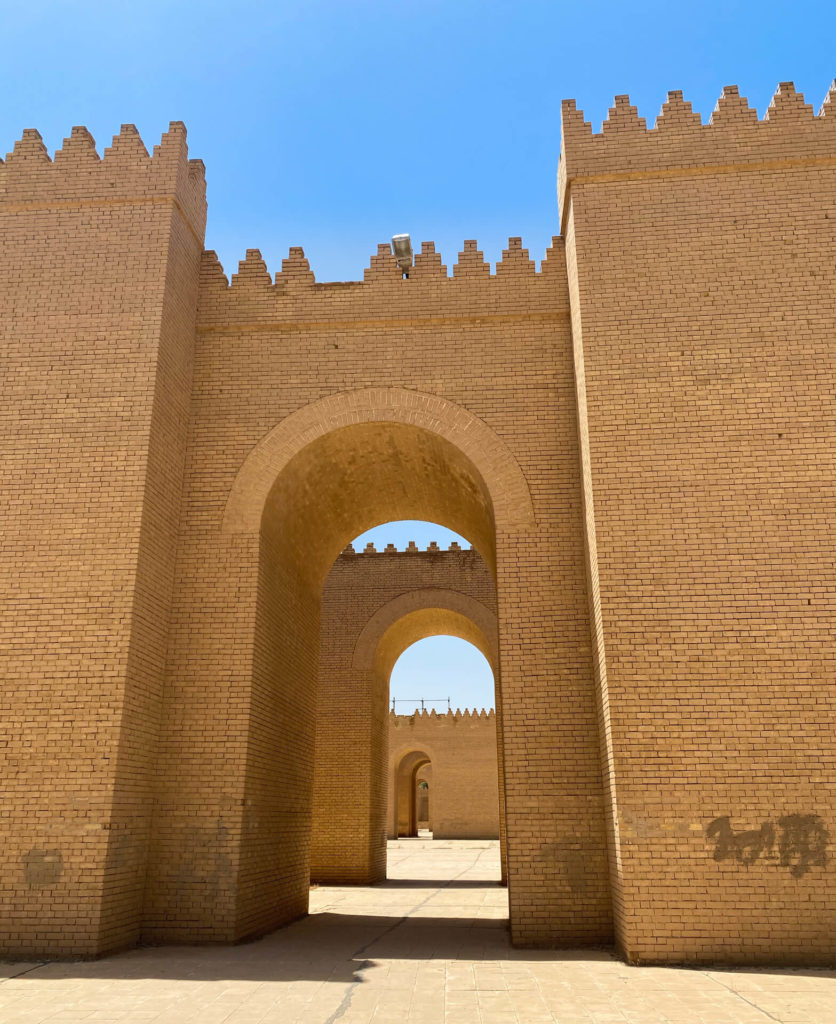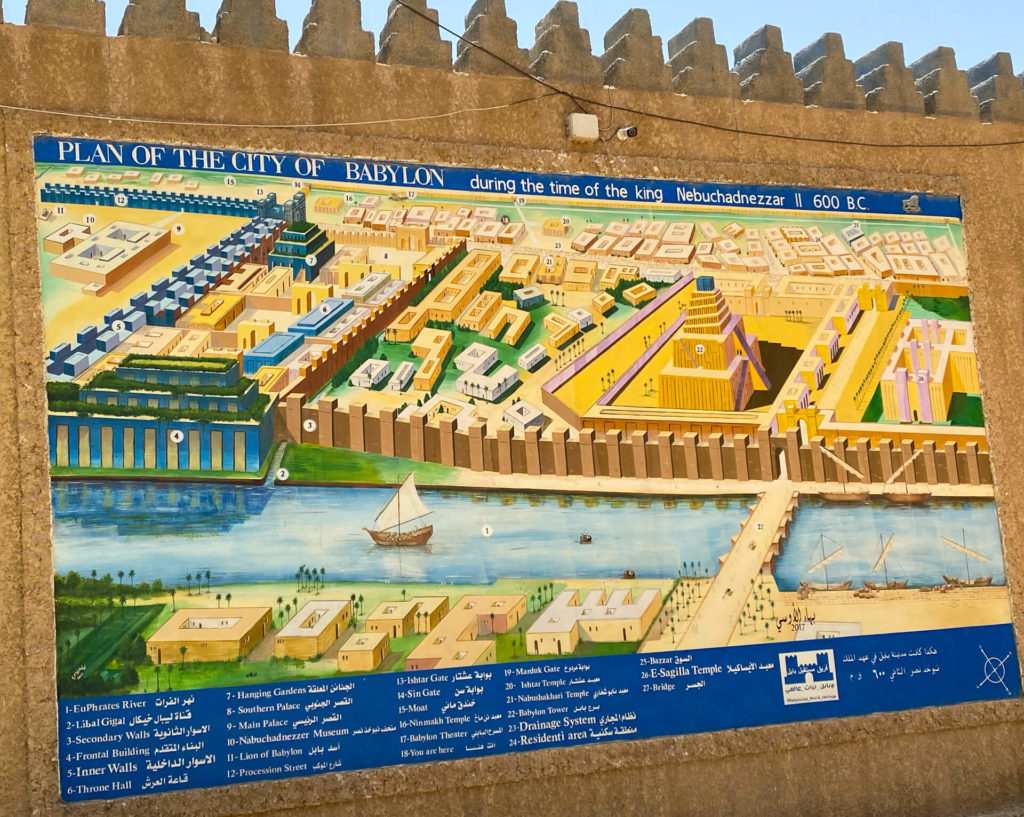
There are so many aspects to the Devil’s Endtime Deceptions it is hard to know what to post or what order to post. I have over a thousand posts in the works. Prioritizing is a nightmare.
Today, I want to again highlight that the real threat to the World is coming from the Middle East. People just don’t understand how things and people are tied together. You cannot point at one group. And even all people in a group are not evil.
It all goes back to Babylon. I have been saying that for over 30 years. I learned that almost immediately after I was filled with the Holy Spirit who took me into some intense tutelage right out of the gate. Of course, you know, that at the same time that NIMROD was in power, Abraham was under the tutelage of the Holy Spirit. Abraham had two son’s. Ishmael his first born by his wife’s handmaiden, and Isaac the son of promise from his barren wife Sarah.
NIMROD was the Father of False Religions. Abraham was the Father of all who walk by Faith in GOD. There has been nothing but war ever since. War between the people of GOD and the people of the DEVIL. War between the children of Ishmael and the children of Isaac. Ishmael was born because Sarah and Abraham chose to try to fulfill God’s promise by their own works. The children of Ishmael have been trying to steal the promise ever since. They are born with resentment, rebellion and murder in their hearts.
Now, since Jesus/Yeshua came and paid the price, they no longer have to walk in all that. BUT, many if not most of them choose to do so. Many are saved and many more are getting saved every day. SO, pray for them. Also pray for the Jews/Hebrews. They are walking in blindness because they are descendants of the Jews who called for Jesus/Yeshua’s death. God has them deaf and blind for a time. For our sake, so that all the gentiles have an opportunity to receive salvation/redemption. Many of them are also getting saved.
But, in the meantime. The whole world suffers, because sin is in the WORLD, and Satan and his minions are deceiving all whom they can.
This post started with the following video. Please, let me make this perfectly clear…I DO NOT agree with everything in this video. We are all limited in our understanding based on our own education, experiences, length of time in the Word, and on our individual calling. NONE of us has ALL the TRUTH.
But, there is a lot in this video that everyone should know.
One place where I totally disagree with the guys in the video is that they are telling everyone that the ID and the Vaccine have nothing to do with the Mark of the Beast. I know that is not true. What is true is that it is not the full manifestation of the Beast System nor is it the final MARK. Those will both be disclosed in God’s Time. BUT, the digital ID/and the stuff that is in the Vaccine are part of the manner in which the Beast System will be planted in you, and enforced. And whether anyone wants to recognize it or not, it is the fruit of our own WRONG CHOICES. It came about because people have turned from trusting GOD and are trusting in “SCIENCE”, TECHNOLOGY and the MEDICAL INDUSTRY. All of these come from ONE SOURCE and that is the DEVIL. The TOOL the Devil is using to bring in his NWO is the UNITED NATIONS. And I do believe, along with the brothers in the video that the BEAST SYSTEM will be MUSLIM/ISLAMIC.
spacer
spacer
that you will take up this taunt against the king of Babylon, and say,
“How the oppressor has ceased,
And how fury has ceased!
“The Lord has broken the staff of the wicked,
The scepter of rulers
Which used to strike the peoples in fury with unceasing strokes,
Which subdued the nations in anger with unrestrained persecution.
and on her forehead a name was written, a mystery, “BABYLON THE GREAT, THE MOTHER OF HARLOTS AND OF THE ABOMINATIONS OF THE EARTH.”
The woman whom you saw is (Babylon) the great city, which reigns over the kings of the earth.”
Revelation 18:23
for your merchants were the great men of the earth, because all the nations were deceived by your sorcery.
spacer

President Joe Biden’s recent visit to Jeddah, Saudi Arabia was dominated by controversy stemming from his meeting with Saudi Crown Prince Mohammed bin Salman (MBS), which drew media attention away from the presence of leaders from Egypt, Jordan, and Iraq at the summit, and from the United States’ support for their recent tripartite alliance. The countries in this group are clearly no match for the wealth of the Gulf Cooperation Council (GCC) countries, but they nonetheless represent longstanding political interests in the Arab world that remain important and should not be ignored. Whether this tripartite group will ultimately become a rival to, or an appendage of, the GCC states is an open question; but the three countries seem to be intensifying ties with each other while at the same time making sure that they stay in the good graces of the Gulf states.
The Developing Egypt-Jordan-Iraq Nexus
| Nexus – Definition, Meaning & Synonyms – Vocabulary.com Nexus entered English during the seventeenth century from the Latin word nectere, meaning “to bind or tie.” People tend to use this word to describe the point where different things or ideas come together or intersect. |
| nexus (n.) 1660s, “bond, link, interdependence between members of a series or group; means of communication,” from Latin nexus “that which ties or binds together,” past participle of nectere “to bind,” from PIE root *ned- “to bind, tie.” |
spacer
Egypt, Jordan, and Iraq have not always been close friends. Indeed, during the so-called Arab Cold War of the 1950s, Egypt, under the leadership of Gamal Abdel-Nasser, cast Jordan and Iraq as pawns of British imperialism, with Nasser especially critical of Iraqi leadership for agreeing to the western-supported security alliance known as the Baghdad Pact. Even after Iraq went through a revolution in 1958 that ended the pro-British monarchy, Egyptian-Iraqi relations remained highly contentious since then Iraqi leader Brigadier General Abd al-Karim Qasim did not wish to be under Nasser’s thumb. Underscoring these tensions was the fact that Cairo and Baghdad were traditional rivals for leadership in the Arab world.
However, in recent years, these three countries have come together to form a sort of alliance based on shared security, political, and economic interests. Since 2019, a number of meetings have been held between leaders and cabinet-level officials from Egypt, Jordan, and Iraq, with the most recent having been held between the countries’ respective foreign ministers on June 2022 in Baghdad. After that gathering, Iraqi Foreign Minister Fuad Hussein spoke of “joint cooperation” to address challenges such as consequences of the war in Ukraine, while his Jordanian counterpart, Ayman al-Safadi, noted an agreement to supply Iraq with electricity from Jordan, underscoring that “Iraq’s security is our security.” Meanwhile, Egyptian Foreign Minister Sameh Shoukry emphasized that the enhancement of relations between the three countries is intended to “support Iraq and strengthen Iraq’s position in the region and the world.”
A desire to promote regional stability, combat extremism, and lessen Iraq’s dependence on Iran, is also behind the endeavor.
A desire to promote regional stability, combat terrorism and extremism, and, for Egypt and Jordan, to lessen Iraq’s dependence on Iran, is also behind the endeavor. And on the economic side, all three countries appear interested in working to boost trade and increase investment in infrastructure, agriculture, and construction, while also establishing new energy links, particularly new oil and gas pipelines. One plan already exists to build an oil pipeline from Basra in Iraq to the Jordanian port of Aqaba, and from there on to Egypt. This plan would lessen transportation costs for the export of Iraqi oil, allow Jordan to acquire transit fees, and provide Egypt with additional energy supplies.
Although Iraq is an oil-rich country, its economy has for many years been battered by war, terrorism, corruption, and instability. Egypt and Jordan undoubtedly hope that if Iraq stabilizes and its economy rebounds, their own companies will benefit in the rebuilding process. For example, Cairo wants its construction companies to be put to use in Iraq, while Jordan, which suffers from even higher unemployment than Egypt, and particularly among its youth, hopes that trade and investment with Iraq will spur economic growth and make a dent in its jobless rate.
Shared Regional Outlooks, but with Some Differences
All three countries also have an interest in opposing the so-called Islamic State (IS) and do not want the group, or another variation of it, to reemerge. Iraq is perhaps the most vulnerable to such a resurgence because IS cells are still active in many parts of the country. Meanwhile, an IS affiliate in Egypt has largely been confined to the northern part of the Sinai Peninsula, and Jordan’s security services keep a close eye on extremists in the country. Hence, security cooperation and intelligence sharing, in cooperation with the United States and other western countries, can form a bridge between the three countries.
There are, however, some slight differences in the countries’ respective positions on Syria. Both Egypt and Iraq have established diplomatic relations with Bashar al-Assad’s government—Egypt because it wanted to show solidarity with Damascus for fighting against what it saw were Islamist forces, and Iraq because of Shia solidarity links with Assad’s Alawi-dominated regime, which even led many Iraqi Shia to volunteer to fight in the Syrian civil war on behalf of the Assad government. Jordan, on the other hand, was initially opposed to the Assad regime in Syria’s civil war, and has continued to host over 670,000 Syrian refugees. However, relations between Amman and Damascus appear to be on the mend, as Assad and Jordan’s King Abdullah held a friendly phone conversation in early October 2021, signaling a warming of ties. Egypt, Iraq, and Jordan all want a unified Syria and the return of Syrian refugees, though carrying out that p
Iran, meanwhile, represents a more complicated problem. The Jordanian monarch was the first Arab leader to publicly raise the alarm about a so-called “Shia crescent” in December 2004, warning that Iran was extending its influence through Iraq and then through Syria and Lebanon—something that the king strongly opposed. Egypt has been less alarmed by Tehran, perhaps because of Egypt’s geographic distance from the Gulf. However, Cairo remains concerned about Iranian maritime activity in the Red Sea, which could potentially disrupt shipping through the Suez Canal, from which Egypt brings in substantial revenue. Egypt and Jordan seem to appreciate that Iraqi caretaker Prime Minister Mustafa al-Kadhimi is in a tight fix, needing to maintain cordial relations with Iran because of pro-Iran, Iraqi Shia political parties, and because of the substantial economic and religious ties between the two countries. Nonetheless, Egyptian and Jordanian leaders see al-Kadhimi as more of an Iraqi nationalist than a Shia leader, and want to help him distance Iraq from Iran as much as possible and instead move closer to the Arab world. The challenge here is that any future Iraqi prime minister from a Shia background may not be as willing to do so as al-Kadhimi appears to be.
Differences also exist on the Arab-Israeli issue, though probably fewer than meet the eye. Both Egypt and Jordan have long had diplomatic relations and economic ties with Israel, while the Iraqi parliament, meanwhile, has criminalized normalization with Israel, influenced in part by Iranian pressure. However, both Egyptian and Jordanian officials have been outspoken on Palestinian rights, much more so than the Gulf states, some of whom have recently established formal relations with Israel. Indeed, while in Jeddah at the recent summit, Egyptian President Abdel-Fattah el-Sisi and Jordan’s King Abdullah called for the “establishment of a Palestinian state on the June 4, 1967 borders with East Jerusalem as its capital.” No other Arab heads of state at the Jeddah summit were so explicit in articulating this position, even though it was first expressed by then Saudi Crown Prince Abdullah bin Abdulaziz in 2002, in what became known as the Arab Peace Initiative. It is therefore unlikely that the Iraqi public will make much of Jordan and Egypt’s ties with Israel as long as Cairo and Amman stick to their platforms.
Complex Relations with Saudi Arabia and the GCC States
There is some speculation that the tripartite alliance may become a rival to the GCC states. But in truth, the situation is more complex. To be sure, for historical and political reasons Egypt, Jordan, and Iraq see themselves as the heart and soul of the Arab world with years of diplomatic experience under their belt. Indeed, a former Egyptian foreign ministry official underscored in an interview just prior to the Jeddah summit that “Egyptian-Arab coordination is in the interest of Arab national security.” In other words, Egypt has the military, security, and diplomatic experience that, according to this line of thinking, the Gulf countries continue to need.
There is undoubtedly resentment among the countries in this tripartite alliance that leadership of the Arab world has shifted to the Gulf. But all three countries understand that because their economies are in such bad shape they will be forced to continue to rely on the largesse of Saudi Arabia and the other GCC states for some time to come. For example, Egypt imported 80 percent of its wheat from Russia and Ukraine last year, meaning that Russia’s war, which has disrupted trade and contributed to higher food and oil prices worldwide, represented an extraordinary burden for this country of over 100 million people. In response, in March 2022 the Saudis pledged $15 billion in aid to Egypt, with other GCC states later pledging an additional $5 billion in investments. Egypt therefore cannot afford to alienate these patrons. Nonetheless, Egypt’s—as well as Jordan’s—outreach to Iraq allows them an economic alternative (albeit one that is not as lucrative), should relations with Riyadh sour and Iraq’s economy rebound.
Similarly, Jordan seems to be looking to hedge its bets, especially since it has had rather checkered relations with Saudi Arabia over the past several decades, stretching as far back as the 1920s when the Saudis seized the Hejaz region of the Arabian Peninsula from King Abdullah’s forefather. Although the Saudis by no means want Jordan to falter economically or politically, there have been times in recent years where Saudi Arabia has suspended aid to Jordan over political differences. There is speculation that Jordan’s King Abdullah suspects that MBS wants to replace him as custodian of the Al-Aqsa Mosque in Jerusalem, which is considered the third holiest site in Islam, and the custodianship of which gives Abdullah a certain amount of legitimacy.
King Abdullah seems to have better relations, however, with UAE President Mohammed bin Zayed Al Nahyan. Many Jordanians work in the UAE as civil servants and advisors to the Emirati Armed Forces, a situation that provides significant opportunities for Jordan’s educated middle class. Interestingly, when in 2021 Jordan hosted Iraqi and Egyptian leaders in Aqaba to announce joint development projects, the UAE’s leader was invited as well, but Saudi Arabian leaders were conspicuously absent.
Saudi-Iraqi relations, meanwhile, were strained for many years in the aftermath of the 2003 US invasion of Iraq because Riyadh did not trust the Shia-dominated government in Baghdad. However, once Iraqi Prime Minister Nouri al-Maliki was forced to resign in 2014, relations started to improve, and the Saudis sent an ambassador to Iraq the following year. Like Jordan and Egypt, Saudi Arabia also wants to woo Iraq back into the Arab fold. The announcement at the Jeddah summit that Iraq, which suffers from acute electrical shortages, would be connected to the GCC electric grid was undoubtedly a sweetener for al-Kadhimi, although it is unclear what this will mean for Jordan’s plans to send electricity to Iraq from Egypt. The Saudis also probably appreciate Baghdad’s role in hosting periodic Saudi-Iran talks, even though said talks have yet to lead to any breakthroughs. The fact that Saudi Arabia invited Egypt, Jordan, and Iraq to the Jeddah summit may also underscore Riyadh’s need to keep these relatively poor but influential countries in its orbit. In other words, the invitation may have been as much an act of cooptation as it was a show of Arab camaraderie.
Implications for the United States
Biden’s praise for the Egypt-Jordan-Iraq alliance was also lost in the media coverage of his trip to Jeddah. Biden not only met separately with leaders from each of these countries and promised economic assistance to bolster food security in light of disruptions from the Russian war on Ukraine, but he also called the trilateral partnership an “an example of positive regional collaboration,” and commended “the unique relationship between Iraq, Jordan, and Egypt, which the United States stands ready to support.” Actually, this was not the first time Washington has endorsed the alliance. In June 2021, State Department Spokesperson Ned Price praised Sisi’s visit to Baghdad, calling it “an important step in strengthening regional economic and security ties between Egypt, Iraq, and Jordan and to advance regional stability.”
It seems that Washington wants this alliance to succeed because all three countries have close security and political ties to the United States and, at least in the case of Egypt and Jordan, are still influential in Arab politics. Washington also sees the efforts of both of these countries to try to make Iraq less dependent on Iran as a positive development. Ironically, this group can be considered a sort of new regional alliance, but without the ideological baggage of the Cold War and the legacies of colonialism.
Nonetheless, it would be best for Washington to continue to support the tripartite group, though without trying to direct its policies. Having this alliance develop organically would be best for all concerned, as this not only gives the group legitimacy in the eyes of local actors, but it also promises to produce new and potentially promising approaches that don’t merely rehash those attempted by previous US administrations. At the same time, Washington should see this alliance in more than just security and economic terms and find ways to press these countries’ governments to improve their human rights records and increase good governance. The US should also work on becoming more even-handed on the Israeli-Palestinian conflict. Not only would such policies contribute to long-term stability in Egypt, Iraq, and Jordan, but they would also greatly improve the United States’ image abroad, which would help increase these countries’ cooperation with Washington.
spacer
Newly elected Egyptian President Mohamed Morsi travelled to Saudi Arabia on July 11.
In this exclusive interview, Senior Scholar David Ottaway explains the significance of this trip.

In his first trip abroad, new Egyptian President Mohamed Morsi traveled to Saudi Arabia on July 11 and 12. What does the visit mean? Why would Morsi select the kingdom for his first trip?
It’s hugely symbolic that he decided to go to Saudi Arabia for a number of reasons. First, since the departure of President Mubarak, the Saudis have already provided Egypt with close to $2 billion in financial and economic assistance. That’s the largest amount any foreign government has given the new Egyptian government.
Second, Morsi, who is a member of the Muslim Brotherhood, wants to mend relations with Saudi Arabia because of its very difficult past relationship with the Muslim Brotherhood.
Saudi Arabia and the Muslim Brotherhood have had tense relations in the past. The Saudi kingdom supported former Egyptian President Hosni Mubarak right up until the end, while the Muslim Brotherhood had supported Iraqi President Saddam Hussein against the Gulf sheikhdoms during the 1990-91 Gulf War. Are the new contacts likely to produce real rapprochement or is this a marriage of convenience?
We don’t know yet whether this budding new relationship will go anywhere. Both Morsi and the Saudis are very pragmatic when it comes to foreign policy, and both are going to be cautious in dealing with one another. But the Saudis want to convince the Muslim Brotherhood not to try to export this new brand of Egyptian democracy to Saudi Arabia. And the Egyptians need Saudi money to help them deal with the current economic crisis. So they both need each other for different reasons now.
In the past, the Saudis blamed the Muslim Brotherhood for politicizing the Saudi brand of Islam known as Wahhabism and turning Wahhabis into political activists. This led Osama bin Laden (a Saudi national) and al Qaeda to promote extremism, including a call to overthrow the House of Saud. So that background is a very important factor in the strains between the Saudi rulers and Egypt’s Muslim Brotherhood.
What are the key differences in political outlook between the Saudi royal family and Egypt’s Muslim Brotherhood?
Saudi Arabia is run by the most conservative Islamic sect among the [ultra-conservative] Salafi groups in the Arab world; the Saudis do not have sympathy for any form of democracy. The Muslim Brotherhood in Egypt is in the midst of forging a new form of democracy, which the Saudis do not appreciate and will not support. In fact, the Saudis are supporting the Salafis in Egypt, which are really a rival to the Muslim Brotherhood and close to the Saudis.
One of the other differences is that the Muslim Brotherhood is much more willing to accept a pluralist society. In Saudi Arabia, there are no political parties, no labor unions, and very little civil society. In Egypt, it’s almost the exact opposite. You have lots of political parties, labor unions, civil society. The Muslim Brotherhood accepts the realities of Egypt– realities that the Saudis reject for their own society.
What are the key similarities between the two countries?
Despite all the differences, hundreds of thousands of Saudis go to Egypt every year for vacation, and hundreds of thousands of Egyptians work in Saudi Arabia. So there’s a real appreciation for each other on the societal level.
Now that the Muslim Brotherhood is in power, the two governments have a similar religious outlook. The Saudis at least appreciate the Muslim Brotherhood’s attempt to deepen Islamic values in Egyptian society.
On foreign policy, we still have to see how much they have in common. The Saudis currently have a very close military relationship with the United States. But we don’t know yet if the new Egyptian government will maintain close relations with Washington, but the Muslim Brotherhood is unlikely to antagonize the United States. It has too many political problems at home and too many financial and economic difficulties to resolve. The new government will need the help of the United States and international financial organizations where Washington has great influence—like the IMF and the World Bank—to solve those problems. (I am not so sure the US has much influence in the financial world these days.)
Saudi Arabia and Egypt are the Arab world’s two powerhouses. Do they agree on regional issues, including Iran, the Arab-Israeli peace process, Syria and the Arab uprisings.
Iran is an all-consuming issue for Saudi Arabia; the two countries are the chief antagonists in the Persian Gulf. I expect the Egyptian government to tread very carefully on the issue of re-establishing relations with Iran in order not to antagonize Saudi Arabia and the other Gulf states, given the financial and economic aid that Egypt desperately needs. The Saudis are seeking Egyptian support for their conflict with Iran. The Egyptians could score a lot of points by emphasizing their commitments to the security of the Gulf States.
On the Israeli-Palestinian issue, the Saudis have been pushing for resolution for years. We’ll have to see whether the new Islamist government in Egypt is really going to do something, such as putting more pressure on Israel. That could bring the two countries very close together. The Saudis would be delighted—and would do what they can to get Israel and the Palestinians to resolve their conflict.
On Syria, the Saudis have been very active in providing financial and military help to the Syrian opposition; they have also declared that President Assad of Syria must go.
The Muslim Brotherhood is still not sure what its policy is. They may very well align with the Syrian opposition which has a strong Muslim Brotherhood component to it. This would create another common foreign policy link between Saudi Arabia and Egypt.
Egypt desperately needs economic assistance. Is oil-rich Saudi Arabia likely to help in a meaningful way? What will the Saudis want in return?
The Saudis have said they would provide $4 billion to Egypt, but they’ve only provided a little under $2 billion so far. They will watch and wait to see what the new Egyptian government does vis-à-vis Iran before it hands out the other $2 billion. The Saudis are certainly going to make it clear that the Egyptians should not have a close relationship with Iran.
Kuwait and Qatar have also offered billions of dollars in aid to Egypt, but so far have not delivered that much. They are also waiting to see what the new Egyptian government’s policy toward Iran and the Gulf Cooperation Council which houses all six Arab gulf monarchies.
spacer
Babylon is coming back to life, with its famed Ishtar Gate to be restored by this summer
A new World Monuments Fund project in conjunction with the US embassy in Baghdad aims to repair Iraqi cultural heritage as part of the Future of Babylon project
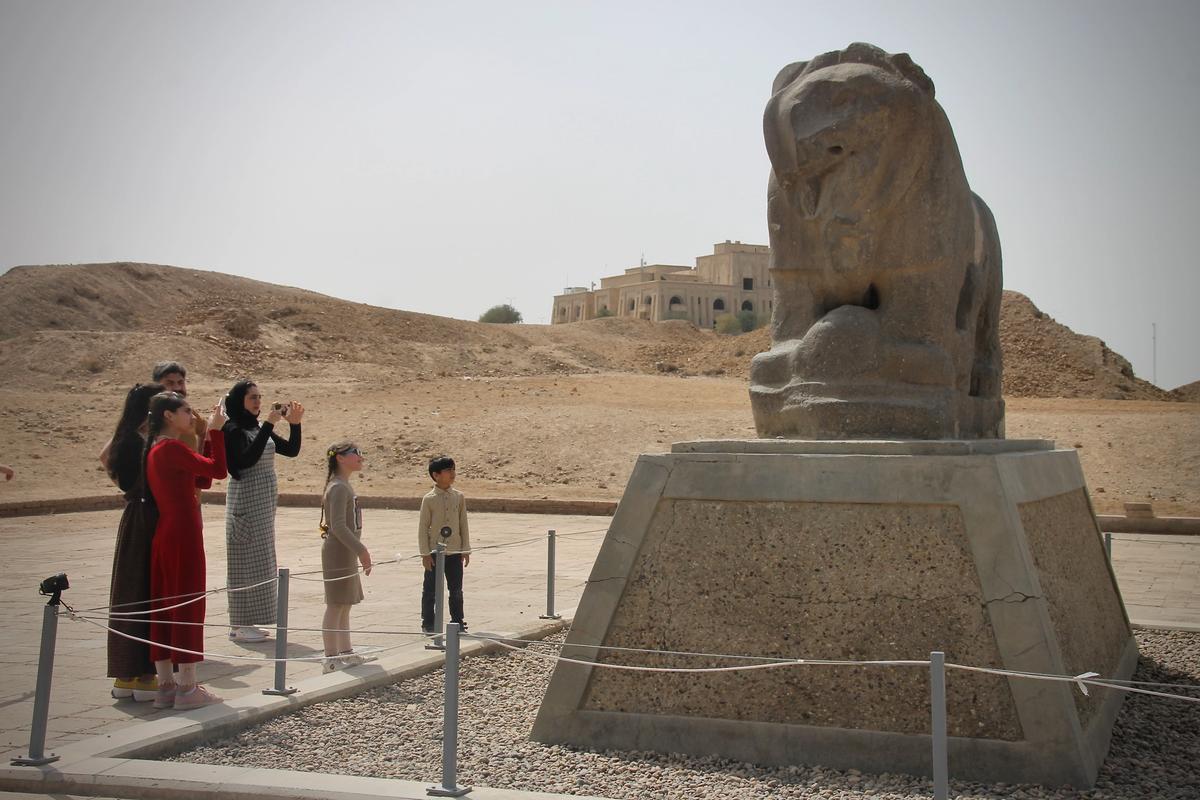
The World Monuments Fund assisted in the conservation of the famous Lion of BabylonPhoto: Hadani Ditmars
|
Media Note Office of the Spokesman
Washington, DC
November 23, 2010
The 6th-century BC Ishtar Gate is one of several landmarks at the ancient site of Babylon in Iraq that will receive much-needed conservation attention under a $2 million grant from the U.S. Ambassadors Fund for Cultural Preservation (AFCP). Established by Congress and marking its 10th year, the AFCP has demonstrated America’s respect for the cultural heritage of other countries by supporting more than 645 projects worldwide. The World Monuments Fund (WMF) will carry out the four-year project in partnership with the Iraq State Board of Antiquities and Heritage (SBAH) and in coordination with the U.S. Embassy in Baghdad. The former imperial capital of Kings Hammurabi and Nebuchadnezzar in southern Mesopotamia from the 18th to the 4th century BC, Babylon was once one of the largest and most influential cities in the world. The Ishtar Gate, Nabu-sha-Khare temple, inner city walls, and other landmarks at this renowned archaeological site are in urgent need of comprehensive conservation to reverse decades of deterioration due to environmental and other factors. The project includes archaeological site preservation, environmental monitoring, and training in the conservation of earthen architecture. For more than 45 years, WMF has worked with communities around the world to support the preservation of their endangered architectural and cultural heritage. This AFCP-supported collaboration with the SBAH at Babylon developed from a broader preservation community concern for Iraqi cultural heritage that has included placing archaeological sites in Iraq on the World Monuments Watch and a WMF-Getty Conservation Institute joint initiative to create a Geographic Information System (GIS) database for archaeological and heritage sites in Iraq to assist with conservation, planning, and monitoring for sites under SBAH jurisdiction. The goals of this work are to develop appropriate conservation solutions, to incorporate holistic preservation approaches embracing environmental, social and economic factors, and to expand SBAH capacity to be an effective steward of Iraqi cultural heritage. The U.S. Ambassadors Fund for Cultural Preservation is administered by the Cultural Heritage Center of the Bureau of Educational and Cultural Affairs, which supports the foreign affairs functions of the U.S. Department of State that relate to the preservation of cultural heritage. The Center also administers U.S. responsibilities relating to the 1970 UNESCO Convention to reduce pillage and illicit trafficking of cultural property. Media Contact: Catherine Stearns, (202) 632-6437 or StearnsCL@state.gov |
|
Media Note Office of the Spokesperson
Washington, DC
December 22, 2015
Today at the Iraqi Museum in Baghdad, the U.S. Embassy Chargé d’Affaires, a.i., Jonathan Cohen and Dr. Ahmed Kamil Murad, Acting General Director of the Office of Museums at the Iraqi Ministry of Culture, State Board of Antiquities and Heritage (SBAH) announced the funding of a project for the rehabilitation and preservation of the Ishtar Gate at the remains of the ancient city of Babylon in Iraq. The U.S. Embassy grant of $530,000 to the World Monuments Fund (WMF) will support conservation work by a team of Iraqi preservationists from the SBAH under the guidance of international heritage experts from WMF. The grant is part of the ongoing cultural partnership between the United States and Iraq in support of the U.S.-Iraq Strategic Framework Agreement. The rehabilitation of the Ishtar Gate is the most recent cooperative venture of the Future of Babylon project – a partnership from 2009 between the Governments of Iraq and the United States and WMF to support Iraqi efforts to assess, document, and preserve the ancient city located south of Baghdad. Since 2009, the Department of State has contributed more than $4 million to the Future of Babylon. With U.S. support, much of the site has been assessed and documented, emergency stabilization work has been undertaken, and completed a site management plan . The Ishtar Gate has stood at the entrance to the ancient city since approximately 575 B.C. when it was constructed under King Nebuchadnezzar II. The remaining parts of the structure are in dire need of conservation to stop further deterioration and to correct modern-era modifications that hasten damage to the monument and that are not historically accurate. Work is expected to be completed in 2017. |
|
Awardee
Grant Description
THIS AWARD IS GIVEN TO WORLD MONUMENTS FUND TO IMPLEMENT FUTURE BABYLON PROJECT ON COMPLETING THE CONVERSATION OF ISHTAR GATE
Grant Program (CFDA)
Awarding Agency
Funding Agency
Place of Performance
Iraq
Geographic Scope
Foreign
Related Opportunity
None
Notes
Amendment Since initial award the End Date has been extended from 12/31/16 to 03/31/23 and the total obligations have increased 136% from $535,331 to $1,265,331.
|
As soaring melodies from a concert at the amphitheatre built by Saddam Hussein in the 1980s, on the ruins of a third-century BC foundation, drifted over from the newly revived Babylon festival, the WMF programme director Jeff Allen told The Art Newspaper: “The project will help usher in new tourism initiatives designed to enhance the visitor experience and help the local economy. It will also train and employ local Iraqis in heritage conservation techniques.”
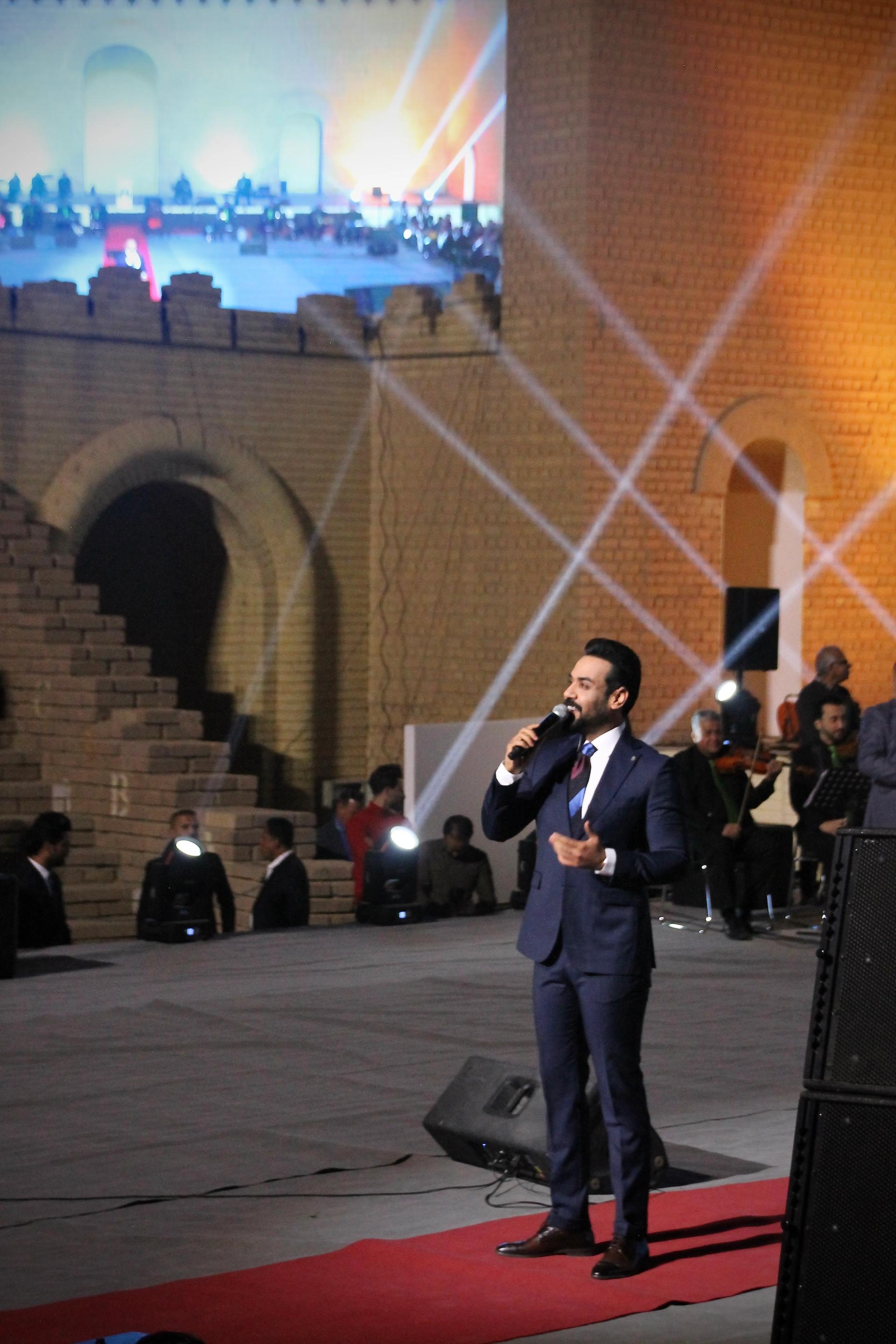
The Babylon festival was revived last year and the 2022 edition is taking place this month and features the famous Iraqi singer Ali JasimPhoto: Hadani Ditmars
The new initiative is part of the WMF’s 15-year commitment to conservation efforts as part of its Future of Babylon project, initiated in 2008. Collaborating with the Iraqi State Board of Antiquities and Heritage (SBAH) until 2015, the WMF performed extensive surveys and documentation and developed conservation plans. The organisation also assisted with a Unesco World Heritage nomination for Babylon that culminated in its inscription in July 2019 and helped with the conservation and stabilisation of the Lion of Babylon. The projects at the Ishtar Gate and Ninmakh Temple, launched in 2016 and 2019 respectively, will be the beneficiaries of the US embassy funding.
Babylon was once the pet project of Saddam Hussein, who envisioned himself as a neo-Nebuchadnezzar, and often referred to a Quranic passage linking the ruler of the Babylonian Empire to the liberation of Palestine. To his credit, his budget for upkeep was much higher than the one currently managed by the Iraqi government, but his labour of love and self-aggrandisement—he had stones inscribed with his name as in other ancient sites—also involved much heavy-handed reconstruction in the 1980s and 90s, often using cement bricks and other inappropriate building materials.
Hussein’s interventions, neglect resulting from 12 years of draconian UN sanctions that bankrupted the country, and subsequent damage by military vehicles in the wake of the 2003 invasion all contributed to Babylon’s demise.

Ninmakh Temple at Babylon is undergoing urgent repairsPhoto: Hadani Ditmars
Construction, too, has taken a toll over the years. In 1927, the British ran a railway line through the site, and in the 1980s Hussein built a highway through part of it, along with a palace for himself, complete with a helipad. There are still three existing but non-functioning oil pipelines, two of which were built in the 1970s and 80s and the third of which is more recent—work on it was blocked after the SBAH filed a lawsuit in 2012.
But today, with renewed internal and foreign tourism and funding from the US embassy and other international donors, Babylon is coming back to life. Its still-eerie, grandiose Hussein-era palaces and guesthouses are filled with international artists invited for the Babylon festival, and thousands of Iraqis flock here every month for parties, weddings and musical boat rides along the Euphrates river.
The current WMF work at the Ishtar Gate—the eighth and most elaborate gate to the inner city of Babylon, whose north facade was reconstructed and displayed in the Pergamon Museum in Berlin in 1930—is addressing issues around changing groundwater levels and its impact on masonry humidity.
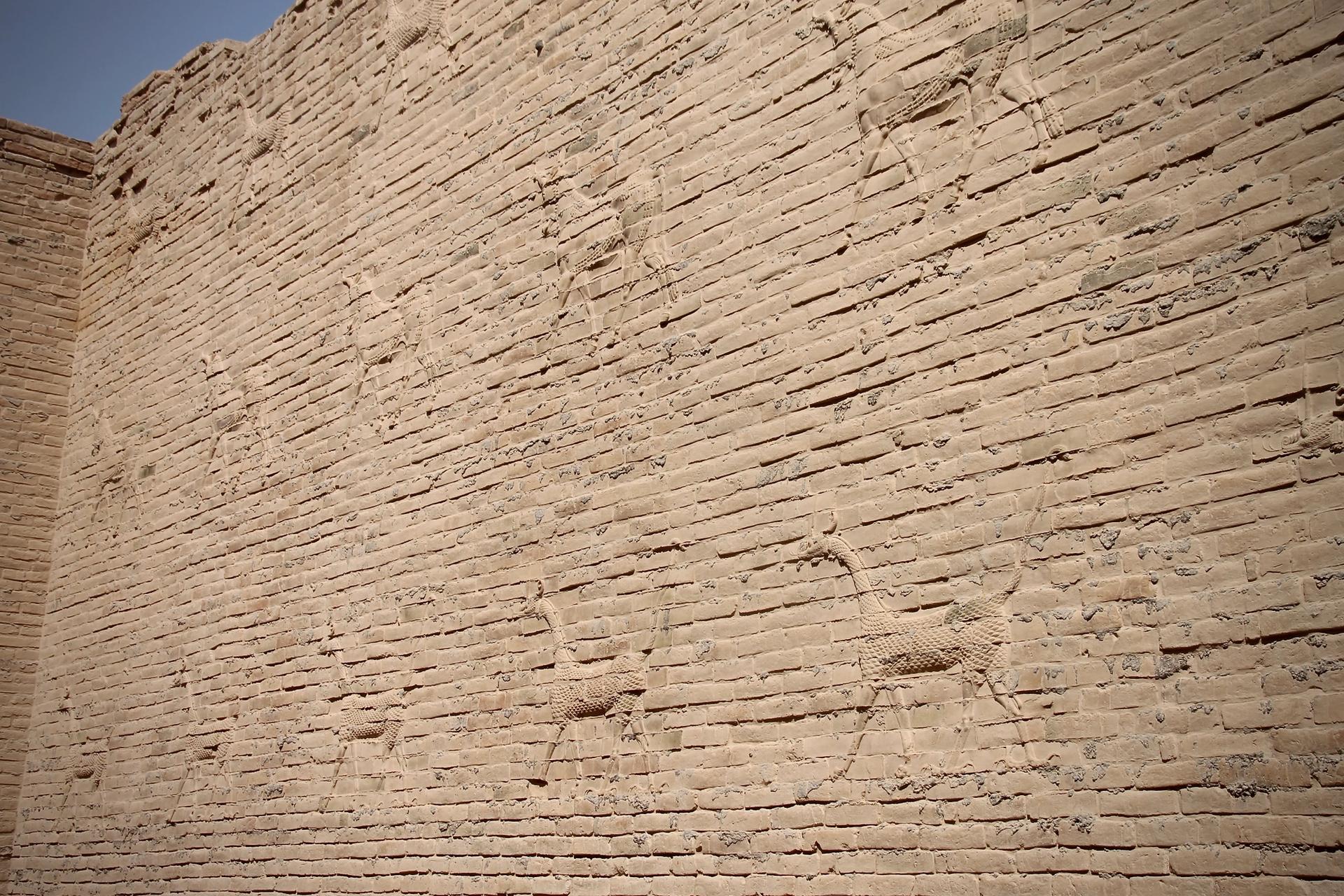
The north façade of the Ishtar Gate, similar to the one pictured here in Babylon, was smuggled out of Iraq and is now housed in the Pergamon Museum in BerlinPhoto: Hadani Ditmars
According to the SBAH archaeologist Ammar Altaee, although Hussein-era interventions did use some mud and straw-baked bricks, which allowed for proper drainage, the concrete bricks they used that absorb but can’t expel moisture have caused significant damage. Current plans, detailed in conceptual drawings, will address drainage issues with façades of metal netting and local stones. The delicate repair job unfolds brick by brick, with layers from interventions in 1958, when King Faisal was in power, joining Hussein-era concrete and mud bricks, being replaced where possible by newly made baked and fired mud bricks, produced in local workshops in nearby Borsippa. The production of the new bricks, sized and coloured to match the original Babylonian ones (the Hussein-era ones were too small and not the right shade) is simultaneously reviving traditional masonry and training new practitioners.
Brick reliefs of bulls and dragons, referencing Marduk the supreme god of Babylon and facing incoming visitors to protect the city from evils, look on as repairs to a dangerous staircase make the area a safer experience for tourists.
| Marduk | God, Tiamat, Mesopotamia, Description, & Facts Marduk, in Mesopotamian religion, the chief god of the city of Babylon and the national god of Babylonia; as such, he was eventually called simply Bel, or Lord. Originally, he seems to have been a god of thunderstorms. |
Meanwhile at the temple of Ninmakh—the Sumerian goddess said to have created man from a mixture of mud and the blood of a murdered god—urgent repairs are underway to secure damaged walls before the next winter rains cause them to collapse. The mud-brick walls were weakened by a Hussein-era concrete roof that they could not support, which collapsed in 1999, and a second mud roof that replaced it, which was damaged by post-invasion military occupation.
Gazing out at an ancient well that local legend says is the abode of the mischievous angels Harut and Marut—hung there for eternity by God for teaching magic to mortals—the WMF project manager Osama Hisham notes: “This is only one of many temples that need urgent repair.”
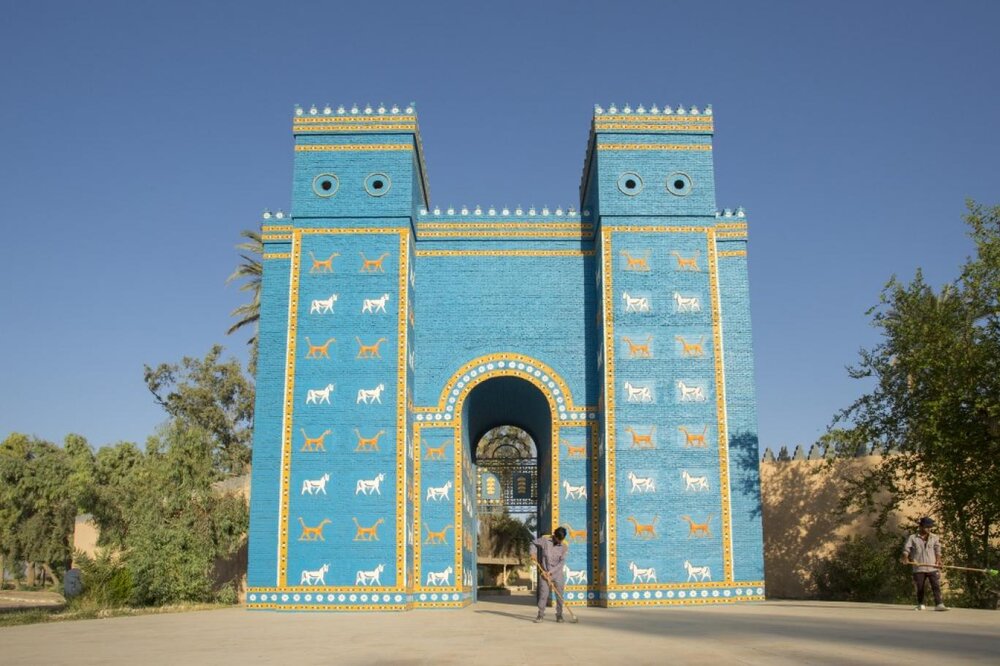
TEHRAN – Surveying and excavating the historical sites of Babylon in Iraq along with assessing the need for restoration is planned to be carried out by Iranian archaeologists, CHTN reported on Sunday.
As a part of a memorandum of understanding signed by the governor of the western Iranian province of Ilam Hassan Bahramnia and the director of the governmental Babel Antiques Organization Hussein Falih on Friday, the exploration of Babylon’s ancient sites will be performed by archeological teams from Ilam province in the near future.
Further, Iraqi tourists are scheduled to visit tourist sites and recreational areas, as well as health tourism facilities in Ilam for Iraqi patients requiring treatment.
Ruled by Hammurabi, restored by Nebuchadrezzar, and conquered by Cyrus the Great, Babylon is located in the heart of Mesopotamia, between the waters of the Euphrates and the Tigris some 97 kilometers south of Baghdad.
It was the capital of southern Mesopotamia (Babylonia) from the early 2nd millennium to the early 1st millennium BC and the capital of the Neo-Babylonian (Chaldean) empire in the 7th and 6th centuries BC when it was at the height of its splendor. I
According to Britannica, when the Persian Achaemenid dynasty under Cyrus II attacked in 539 BC, the capital fell almost without resistance.
Under the Persians, Babylon retained most of its institutions, became the capital of the richest satrapy in the empire, and was, according to the 5th-century-BC Greek historian Herodotus, the world’s most splendid city.
Home to almost half of Iran’s UNESCO sites, western Iran is a land of hospitable people, wild extremes, and wilder history, and it may be an independent traveler’s adventure playground. The region also witnessed the rise and fall of many great empires once bordering Mesopotamia, Ottoman Turkey, and Czarist Russia.
From the fecund Caspian coast to the stark, mountainous northern borders, and the crumbling desert ruins of the southern plains, the region hosts everything from paddy fields to blizzards to Persian gardens.
ABU/AM
|RUINS OF BABYLON, IRAQ
At the temple of Ninmakh, the Sumerian mother goddess, Iraqi archaeologists are using 7,000-year-old techniques to protect the monument, and the rest of the ancient city of Babylon, from salt seeping into its heart and destroying it from within.
Ninmakh Temple at Babylon | World Monuments FundNinmakh was a mother goddess in ancient Mesopotamia. Her dedicated temple was first excavated by Hormuzd Rassam in 1880 before being re-excavated by archaeologists of the Koldewey Expedition (1899–1914) and later reconstructed by Iraqi archaeologists in the 1960s. Monuments Fund has been committed to conservation efforts at Babylon for over fifteen years through an initiative known as the Future of Babylon Project that has included documentation, conditions surveys, development of conservation plans, and the creation of the Babylon Site Management Plan (BSMP), as well as physical interventions at the Lion of Babylon and Ishtar Gate. WMF’s project at Ninmakh Temple—supported by the US Embassy in Baghdad—focuses on the thorough study, documentation, and subsequent restoration of the building. A priority component of the project is also training the project team in conservation techniques for unbaked mudbrick, different from baked brick, the primary material used for the Ishtar Gate. WMF will engage local and international experts to mentor the local project staff and build their transferable skills to ensure the sustainability of Babylon’s built heritage. Project activities will also improve the temple’s infrastructure and visitor amenities, for its envisioned reuse as a cultural venue. Last updated: January 2023.
|
spacer
SO, now you have seen enough proof that our US Dollars since 2008 have been going to REBUILD BABYLON!!! SERIOUSLY?? I WONDER HOW MANY UNITED STATES CITIZENS have EVER BEEN aware of that fact. I also wonder how many United States citizens would be in favor of it if they knew. How many state governments were aware of it?? WE are REBUILDING PAGAN TEMPLES and IDOLS!! WHAT??? NOT JUST ANY PAGAN TEMPLES, but the entire CITY OF BABYLON, which GOD destroyed!!! And not just the CITY, we are building the Government and the Religion of the TOWER OF BABEL!!
With carefully made desalinated mudbricks, they are repairing the ruins of the UNESCO World Heritage site, which are being corroded by the intrusion of increasingly salty groundwater – a problem linked to prolonged droughts and soil erosion in climate-vulnerable Iraq.
“Salty groundwater is our greatest enemy,” said Ammar al-Taee, an archeologist with the Iraqi State Board of Antiquities who oversees the project and calls himself wryly “the guardian of Babylon.”
The ancient Mesopotamian city on the Euphrates River was once the center of a sprawling empire, renowned for its towers and mudbrick temples. Its hanging gardens, built about 2,600 years ago, were one of the seven ancient wonders of the world.
Problems such as salt intrusion, extreme temperatures, flooding, and soil erosion, linked in part to climate change, are threatening heritage sites in Iraq and around the world, from indigenous rock art in Australia to Bangladesh’s 15th century “Mosque City.”
Mr. Al-Taee and his team learned the painstaking, months-long process of making special low-salt mudbricks from a local artisan who had inherited the age-old technique from his father, and they produced their first batch for repairs this year.
Next, the mud was mixed with sand, grit, straw, and water, shaped into a large circle, and left to ferment for a month, a process that drives the remaining salt to the edge of the mix, producing a white, crystalline fringe.
After scraping away the unwanted salty crust, the remaining sludge was then shaped into bricks, which were laid out on plaited reed mats woven by local women’s cooperatives, giving the blocks a distinctive pattern.
The whole process reduces the amount of salt in new mudbricks by almost three-quarters, Mr. Al-Taee said.
Once they had been stacked in the shade of a tree for a couple of days to air, the bricks were spread out in the sun to bake for a month before being ready for use.
Modern maintenance work on some of Babylon’s monuments used concrete and cement to repair damaged facades and fill cracks, a method he said had exacerbated damage arising from rising salt levels combined with the region’s high humidity.
Another of the projects that Mr. Al-Taee works on involves removing concrete from around the ruins and replacing it with more porous material, such as river stones, another construction technique employed by the area’s residents in past millennia.
“Humidity doesn’t like cement and concrete. It can’t get out of it, so it began going after the weaker places. Of course, mudbrick is weaker, so it started exiting through it,” he said.
That accelerated the erosion of the mudbricks and the numerous engravings that once adorned the walls next to the Ishtar Gate, a colossal structure that towered over Babylon’s main thoroughfare.
An inscription of Marduk, Babylon’s chief deity, still decorates the walls leading to the gate, depicting the god as a hybrid sphinx-like creature with the head of a snake, the front legs of a lion, and a scorpion’s tail.
But below him, an image of Adad, the god of weather, is barely visible – lost to the ravages of time and climate change.
Of the original engraving of a bull, only a hoof can be seen today, and the lower parts of the walls are stained with salty white veins.
Despite the magnitude of the problem, Mr. Al-Taee said he receives no support from the Iraqi government. His current projects depend entirely on foreign funding.
“The lack of support and investment from the government is our biggest challenge,” he said, pointing to the high cost of basic supplies – even clean water, which has become more expensive in drought-plagued Iraq.
The Iraqi government did not immediately respond to a request for comment.
In addition to warding off salt, Babylon’s archaeologists must fight pests that have beset the ruins as the palm trees and vegetation around the ancient city have withered in the parched conditions of recent years.
Mites and wasps that used to feed on the greenery have started to eat away at the mudbrick walls and foundations. Chemical pesticides cannot be used due to the damage they might cause to the ruins, so Mr. Al-Taee has to smoke out the pests instead.
Many of Iraq’s other ancient sites are also feeling the effects of worsening drought.
At the site of the Sumerian city of Girsu, the foundations of the world’s oldest known bridge are being eaten away by salty sandstorms as desert-like conditions spread around the southern city of Basra, where seawater is seeping into the land and destroying fertile soils.
“It’s like a weaponised dust storm – crystals that destroy,” said Jaafar Jotheri, a professor of geoarchaeology at Iraq’s University of Al-Qadisiyah and one of those working on a project to conserve the 4,000-year-old bridge.
Salt is also causing damage at the ruins of Uruk, the first city where writing is known to have been practiced.
spacer
I was just curious, how all these places tie in together. I know that Saudi Arabia and Egypt are working together to build NEOM. So, I decided to pull up Google and see where the sites line up. I looked for Mt Sinai, Babylon, Cairo, NEOM and Riyadh. Below is the map, I connected the dots and discovered that the ensuing triangle also took in Jordan and Palestine. You may or may not be aware of the fact that CAIRO is bringing back the PHARAOHS. Well, at least they are bringing back the WORSHIP of the Pharaohs. They brought their mummy’s back a few years ago. They are now all in a Great Hall in Cairo.
ARE YOU GETTING THE PICTURE?? The United Nations was NEVER about bringing peace among the Nations. It has ALWAYS been about taking us back to BABEL!! Back TO EGYPT. Back to serving the FALLEN ANGELS. spacer

Vol. 11, No. 4


.
The lavishly decorated Ishtar Gate was one of the city gates of ancient Babylon in present-day Iraq, built by the Babylonian king Nebuchadnezzar II in the 6th century BCE. But it is also a masterpiece of Babylonian architecture: the reconstructed version is the highlight of any visit to the Vorderasiatisches Museum (Museum of the Ancient Near East) housed in the Pergamon Museum on Museum Island in Berlin. Above all, the Ishtar Gate carries great symbolic significance for contemporary Iraq. The gate therefore may be interpreted quite differently depending on the individual observer’s perspective and background, and we can see multiple narratives come together in this single monument.
 Model of the Ishtar Gate, the Processional Way, and the North Gate, which was discovered later (after O. Pedersén, Babylon. The Great City (2020), Fig. 2.34).
Model of the Ishtar Gate, the Processional Way, and the North Gate, which was discovered later (after O. Pedersén, Babylon. The Great City (2020), Fig. 2.34). The remains of the Ishtar Gate’s two older construction phases at the time the excavation began, Babylon 1902 (Staatliche Museen zu Berlin – Vorderasiatisches Museum, Deutsche Orient-Gesellschaft, photographer unknown).
The remains of the Ishtar Gate’s two older construction phases at the time the excavation began, Babylon 1902 (Staatliche Museen zu Berlin – Vorderasiatisches Museum, Deutsche Orient-Gesellschaft, photographer unknown). ransporting the crates with finds by sailboat to Hilla, where they were loaded onto the train for further shipment to Baghdad and Berlin, 1926 (Staatliche Museen zu Berlin – Vorderasiatisches Museum, Deutsche Orient-Gesellschaft, Photo: Walter Andrae).
ransporting the crates with finds by sailboat to Hilla, where they were loaded onto the train for further shipment to Baghdad and Berlin, 1926 (Staatliche Museen zu Berlin – Vorderasiatisches Museum, Deutsche Orient-Gesellschaft, Photo: Walter Andrae). First, the bricks had to be thoroughly desalinated. To accomplish this, the staff at the Chemical Laboratory of the Royal Museums placed the fragments in barrels of water, which they changed regularly, 1928 (Staatliche Museen zu Berlin – Vorderasiatisches Museum, photographer unknown).
First, the bricks had to be thoroughly desalinated. To accomplish this, the staff at the Chemical Laboratory of the Royal Museums placed the fragments in barrels of water, which they changed regularly, 1928 (Staatliche Museen zu Berlin – Vorderasiatisches Museum, photographer unknown).

 Final touch-ups at the still-standing remains of the Ishtar Gate’s earliest construction phase in Babylon during the ongoing restoration by Iraqi State Board of Antiquities and Heritage and the World Monuments Fund (Photo: World Monuments Fund).
Final touch-ups at the still-standing remains of the Ishtar Gate’s earliest construction phase in Babylon during the ongoing restoration by Iraqi State Board of Antiquities and Heritage and the World Monuments Fund (Photo: World Monuments Fund). The ruins of Babylon today. On the right is Nebuchadnezzar II’s reconstructed royal palace (Southern Palace), on the left Saddam Hussein’s palace on an artificial hill, and in the background the Euphrates (Photo: Iraq State Board for Antiquities and Heritage).
The ruins of Babylon today. On the right is Nebuchadnezzar II’s reconstructed royal palace (Southern Palace), on the left Saddam Hussein’s palace on an artificial hill, and in the background the Euphrates (Photo: Iraq State Board for Antiquities and Heritage).Jeremiah 51:41-48 The Message (MSG)
“Babylon is finished— the pride of the whole earth is flat on her face. What a comedown for Babylon, to end up inglorious in the sewer! Babylon drowned in chaos, battered by waves of enemy soldiers. Her towns stink with decay and rot, the land empty and bare and sterile. No one lives in these towns anymore. Travelers give them a wide berth. I’ll bring doom on the glutton god-Bel in Babylon. I’ll make him vomit up all he gulped down. No more visitors stream into this place, admiring and gawking at the wonders of Babylon. The wonders of Babylon are no more. Run for your lives, my dear people! Run, and don’t look back! Get out of this place while you can, this place torched by GOD’s raging anger. Don’t lose hope. Don’t ever give up when the rumors pour in hot and heavy. One year it’s this, the next year it’s that— rumors of violence, rumors of war. Trust me, the time is coming when I’ll put the no-gods of Babylon in their place. I’ll show up the whole country as a sickening fraud, with dead bodies strewn all over the place. Heaven and earth, angels and people, will throw a victory party over Babylon When the avenging armies from the north descend on her.” GOD’s Decree!
Share
The burden of Babylon, which Isaiah the son of Amoz did see. Lift ye up a banner upon the high mountain, exalt the voice unto them, shake the hand, that they may go into the gates of the nobles. I have commanded my sanctified ones, I have also called my mighty ones for mine anger, even them that rejoice in my highness. The noise of a multitude in the mountains, like as of a great people; a tumultuous noise of the kingdoms of nations gathered together: the Lord of hosts mustereth the host of the battle. They come from a far country, from the end of heaven, even the Lord, and the weapons of his indignation, to destroy the whole land. Howl ye; for the day of the Lord is at hand; it shall come as a destruction from the Almighty. Therefore shall all hands be faint, and every man’s heart shall melt: And they shall be afraid: pangs and sorrows shall take hold of them; they shall be in pain as a woman that travaileth: they shall be amazed one at another; their faces shall be as flames. Behold, the day of the Lord cometh, cruel both with wrath and fierce anger, to lay the land desolate: and he shall destroy the sinners thereof out of it. For the stars of heaven and the constellations thereof shall not give their light: the sun shall be darkened in his going forth, and the moon shall not cause her light to shine. And I will punish the world for their evil, and the wicked for their iniquity; and I will cause the arrogancy of the proud to cease, and will lay low the haughtiness of the terrible. I will make a man more precious than fine gold; even a man than the golden wedge of Ophir. Therefore I will shake the heavens, and the earth shall remove out of her place, in the wrath of the Lord of hosts, and in the day of his fierce anger. And it shall be as the chased roe, and as a sheep that no man taketh up: they shall every man turn to his own people, and flee every one into his own land. Every one that is found shall be thrust through; and every one that is joined unto them shall fall by the sword. Their children also shall be dashed to pieces before their eyes; their houses shall be spoiled, and their wives ravished. Behold, I will stir up the Medes against them, which shall not regard silver; and as for gold, they shall not delight in it. Their bows also shall dash the young men to pieces; and they shall have no pity on the fruit of the womb; their eyes shall not spare children. And Babylon, the glory of kingdoms, the beauty of the Chaldees’ excellency, shall be as when God overthrew Sodom and Gomorrah. It shall never be inhabited, neither shall it be dwelt in from generation to generation: neither shall the Arabian pitch tent there; neither shall the shepherds make their fold there. But wild beasts of the desert shall lie there; and their houses shall be full of doleful creatures; and owls shall dwell there, and satyrs shall dance there. And the wild beasts of the islands shall cry in their desolate houses, and dragons in their pleasant palaces: and her time is near to come, and her days shall not be prolonged.

